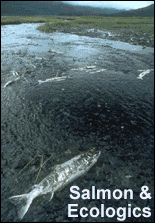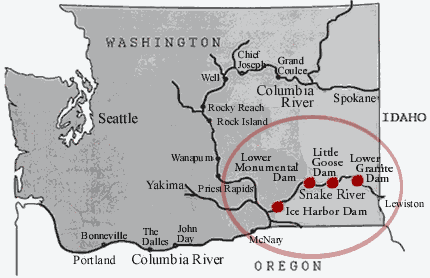Fish :
Dams :
Aluminum :
Irrigation :
Navigation :
Rail :
Rates :
Overgeneration :
Efficiency :
Solar :
Wind :
Biomass :
Geothermal :
Wave/Tidal :
Nuclear :
Fossil Fuel :
Other Energy :
Smart Grid :
Transmission :
Climate Change :
Misc. :
Energy Efficient Goods Popular (2001)
You can see the proof that Northwest residents are taking the energy crunch seriously in the light bulb aisle of your local hardware store.
You can see the proof, that is, unless shoppers have already cleaned out the compact fluorescent bulbs -- the low-energy lights that have become the hot consumer item this winter.
"It's been a challenge to keep us supplied," said Fred Meyer spokesman Rob Boley. "We've got two main suppliers that have been working hard to keep us in stock."
Compact fluorescent bulbs are just one of many energy-saving items consumers are snapping up now that the region's looming energy shortage has pushed up electricity costs and brought government pleas to conserve power. Other hot items include insulation, thermostats, timers for lights and water heaters, and energy-efficient appliances.
Many of the products are more expensive than their more energy-hungry counterparts. But the power crisis, financial incentives and technological improvements to energy-efficient goods have made them newly popular.
No item illustrates this better than compact fluorescent bulbs: They cost much more than incandescent bulbs -- about $10 to $20 each. But they can last 10 times longer, up to 10,000 hours under ideal conditions. And they use only a quarter of the power: A 15-watt compact fluorescent bulb offers as much light as a 60-watt incandescent bulb.
-- by Andy Dworkin, The Oregonian (more)
|
NW Wind Power Growing Rapidly (2011)
"Every time we choke down 1,000 megawatts, another 250, 500 or 1,000 megawatts shows up," said BPA's Elliott Mainzer.
. . .
Northwest wind power could more than double by 2025, possibly causing problems for managing the transmission grid, according to a new study.
Wind turbines now operating or under construction can generate a peak output of about 6,000 megawatts, or the equivalent of 15 good-size natural gas-fired power plants, the Northwest Power and Conservation Council said.
Most of that wind power was added in the past five years.
The Portland-based council estimates the region could see another 5,000 to 10,000 megawatts of wind capacity by 2025, The Oregonian reported.
The council is tasked by Congress with developing long-term power plans that balance the region's energy and environmental needs.
Its staff prepared the study released Thursday to provide power planners with a forecast on the upper limit of potential wind development for a region that is already struggling to absorb the rapidly increasing and highly variable output of its expanding wind turbine fleet.
-- by Assoicated Press, Seattle Times (more)
|
Aluminum Companies Seek Deal with BPA (2001)
Federal dams and the BPA are capable of generating and transmitting about 8,400 megawatts of power. The BPA's customers require about 11,000 megawatts, which means the federal agency will have to buy about a quarter of the power it sells to public and private utilities, and to Northwest industries.
About 1,500 megawatts of the BPA's power will go to aluminum mills in Washington, Oregon and Montana. The companies operating those plants have asked for a credit for the power they don't use. They would use that credit to lower their energy cost to the point where they could make a profit on the aluminum they produce.
What the BPA would like them to do is use some of the windfall profits they've made by closing plants and reselling energy this year. According to Mosey, Kaiser Aluminum alone, which has shut down smelters in Spokane and Tacoma, has made a half-billion dollars since last summer by reselling the electricity it didn't use.
-- by Robert T. Nelson, Seattle Times (more)
|
Port of Lewiston at 1970 levels (2011)
The Port of Lewiston is the inland most seaport on the West Coast, more than 400 miles from the Pacific Ocean. A series of dams and locks completed on the Snake in 1975 allow ocean-based commerce to be conducted here, and in two nearby ports in Washington.
But business has dropped sharply at the port, to 1970s levels, just in the past year, prompting longtime critics to suggest that the port -- which gets about 20 percent of its $2.29 million annual budget from local property taxes -- may not be economically viable in the future.
The chief critics are environmental groups which have been fighting for years to have the four Snake River dams breached because they contend the structures have decimated wild salmon runs.
Port director David Doeringsfeld said the number of ships calling on Portland -- where cargo from Lewiston is transferred to oceangoing vessels -- has been down the past couple of years because of the worldwide recession, and that hurts his ability to ship.
-- by Assoicated Press, Tri-City Herald (more)
|
|















